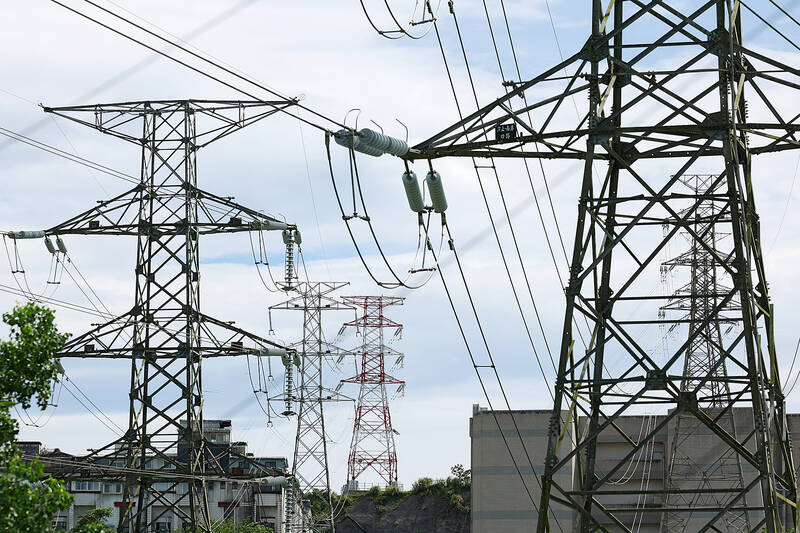Taiwan Power Co (Taipower, 台電) is to raise electricity rates by an average of 0.71 percent, affecting 14 million households and small-scale businesses, while holding rates steady for industrial users, the Ministry of Economic Affairs said yesterday.
The average electricity rate would rise from about NT$3.76 to NT$3.78 per kilowatt-hour (kWh) starting next month, Deputy Minister of Economic Affairs Lai Chien-hsin (賴建信) told a news conference after the electricity price review committee wrapped up a meeting.
Industrial electricity rates would remain unchanged at NT$4.27 per kWh, following multiple price increases over the past few years.

Photo: CNA
Residential electricity, which includes households and small stores, would see an average rate increase of 3.12 percent, Lai said.
The adjustment aims to reflect Taipower’s power generation costs, Lai said.
Taipower currently charges household users NT$2.77 per kWh, significantly lower than its power generation costs of NT$3.8 on average since January.
The latest electricity price hikes would add NT$6.4 billion (US$211.8 million) in revenue, Lai said.
Taipower would raise electricity rates for households based on three tiers: Households that consume less than 700kWh a month would see a price rise of NT$0.1 per kWh, while those using 701kWh to 1,000kWh would see a NT$0.2 increase, and those above 1,001kWh would face a NT$0.4 hike, he said.
The price adjustment would result in a NT$70 increase in the monthly electricity bill of a four-member family using 700kWh a month, he said.
For small stores using less than 700kWh, the power rates would go up by NT$0.1 per kWh, while those consuming more than 700kWh would see no change in their electricity bill, Lai said.
The latest electricity rate increase still fell short of the 6.45 percent rate increase Taipower proposed during the committee meeting to turn its business around, Taipower vice president Tsai Chih-meng (蔡志孟) said.
Although fuel prices have been falling, Taipower still faces accumulated losses of NT$417.9 billion, Tsai said, adding that as a NT$100 billion subsidy program is yet to be approved by the legislature, the company’s financial condition remains tight.
The price hike matched the expectations of most business groups.
A “mild” increase for households and small businesses would be an “ideal” scenario, considering their financial burden and the impact on inflation, General Chamber of Commerce of the Republic of China chairman Paul Hsu (許舒博) said.
“A 3 percent increase for residential users is acceptable,” Hsu said.
The Chinese National Association of Industry and Commerce said the decision to freeze electricity rates for industrial users would help safeguard the competitiveness of local industries and help them endure operational difficulties.
Third Wednesday Club (三 三會)
chairman Lin Por-fong (林伯豐) said the price increases only provided short relief to Taipower, and the nation’s energy policy remains unsolved.
The government should revise its energy policy and reconsider adopting nuclear power, he said.
National Association of Small and Medium Enterprises Republic of China chairman Yu-Jia Li (李育家) said that the government has been considerately curbing electricity rate rises, fearing that any dramatic adjustments would put the public and industries in difficult situations.
Additional reporting by Lisa Wang

CROSS-STRAIT COLLABORATION: The new KMT chairwoman expressed interest in meeting the Chinese president from the start, but she’ll have to pay to get in Beijing allegedly agreed to let Chinese Nationalist Party (KMT) Chairwoman Cheng Li-wun (鄭麗文) meet with Chinese President Xi Jinping (習近平) around the Lunar New Year holiday next year on three conditions, including that the KMT block Taiwan’s arms purchases, a source said yesterday. Cheng has expressed interest in meeting Xi since she won the KMT’s chairmanship election in October. A source, speaking on condition of anonymity, said a consensus on a meeting was allegedly reached after two KMT vice chairmen visited China’s Taiwan Affairs Office Director Song Tao (宋濤) in China last month. Beijing allegedly gave the KMT three conditions it had to

STAYING ALERT: China this week deployed its largest maritime show of force to date in the region, prompting concern in Taipei and Tokyo, which Beijing has brushed off Deterring conflict over Taiwan is a priority, the White House said in its National Security Strategy published yesterday, which also called on Japan and South Korea to increase their defense spending to help protect the first island chain. Taiwan is strategically positioned between Northeast and Southeast Asia, and provides direct access to the second island chain, with one-third of global shipping passing through the South China Sea, the report said. Given the implications for the US economy, along with Taiwan’s dominance in semiconductors, “deterring a conflict over Taiwan, ideally by preserving military overmatch, is a priority,” it said. However, the strategy also reiterated

‘BALANCE OF POWER’: Hegseth said that the US did not want to ‘strangle’ China, but to ensure that none of Washington’s allies would be vulnerable to military aggression Washington has no intention of changing the “status quo” in the Taiwan Strait, US Secretary of Defense Pete Hegseth said on Saturday, adding that one of the US military’s main priorities is to deter China “through strength, not through confrontation.” Speaking at the annual Reagan National Defense Forum in Simi Valley, California, Hegseth outlined the US Department of Defense’s priorities under US President Donald Trump. “First, defending the US homeland and our hemisphere. Second, deterring China through strength, not confrontation. Third, increased burden sharing for us, allies and partners. And fourth, supercharging the US defense industrial base,” he said. US-China relations under

The Chien Feng IV (勁蜂, Mighty Hornet) loitering munition is on track to enter flight tests next month in connection with potential adoption by Taiwanese and US armed forces, a government source said yesterday. The kamikaze drone, which boasts a range of 1,000km, debuted at the Taipei Aerospace and Defense Technology Exhibition in September, the official said on condition of anonymity. The Chungshan Institute of Science and Technology and US-based Kratos Defense jointly developed the platform by leveraging the engine and airframe of the latter’s MQM-178 Firejet target drone, they said. The uncrewed aerial vehicle is designed to utilize an artificial intelligence computer